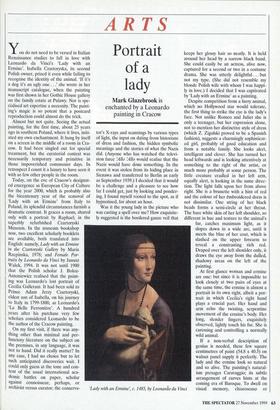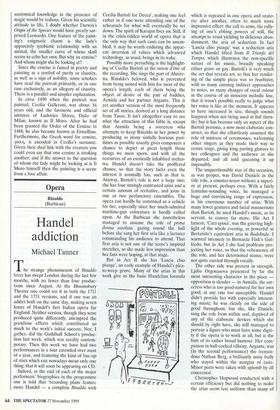ARTS
Portrait of a lady
Mark Glazebrook is enchanted by a Leonardo painting in Cracow You do not need to be versed in Italian Renaissance studies to fall in love with Leonardo da Vinci's 'Lady with an Ermine'. Isabella Czartoryska, its second Polish owner, prized it even while failing to recognise the identity of the animal. 'If it's a dog it's an ugly one she wrote in her manuscript catalogue, when the painting was first shown in her Gothic House gallery on the family estate at Pulawy. Nor is spe- cialised art expertise a necessity. The paint- ing's magic is so potent that a postcard reproduction could almost do the trick.
Almost but not quite. Seeing the actual painting, for the first time, about 25 years ago in southern Poland, where it lives, initi- ated my own enchantment. It hung by itself on a screen in the middle of a room in Cra- cow. It had been singled out for special treatment, but the curatorial context was necessarily temporary and primitive in those impoverished communist days. In retrospect I count it a luxury to have seen it with so few other people in the room.
Today, on the eve of Cracow's designat- ed emergence as European City of Culture for the year 2000, which is probably also the bicentenary year of the removal of 'Lady with an Ermine' from Italy to Poland, its splendid circumstances furnish a dramatic contrast. It graces a room, shared only with a portrait by Raphael, in the superbly refurbished Czartoryski Museum. In the museum bookshop now, two excellent scholarly booklets are available, both translated into English: namely, Lady with an Emsine in the Czanoryski Gallery by Maria Rzepinska, 1978; and Female Por- traits by Leonardo da Vinci by Janusz Walelc, 1994. It was not until 1900 that the Polish scholar J. Boloz- Antoniewicz realised that the paint- ing was Leonardo's lost portrait of Cecilia Gallerani. It had been sold to Prince Adam Jerzy Czartorysld, eldest son of Isabella, on his journey to Italy in 1799-1800, as Leonardo's 'La Belle Ferroniere'. A hundred years after his purchase very few scholars considered Leonardo to be the author of the Cracow painting.
On my first visit, if there was any- thing other than minimal and per- functory literature on the subject on the premises, in any language, it was not to hand. Did it really matter? In any case, I had no choice but to let such anticipated discoveries wait. I could only guess at the tone and con- tent of the usual international aca- demic battles on paper, scholar against connoisseur, perhaps, or archivist versus curator; the conserva- tor's X-rays and scantlings by various types of light, the input on dating from historians of dress and fashion, the hidden symbolic meanings and the stories of what the Nazis did. (Anyone who has watched the televi- sion farce 'Allo 'Allo would realise that the Nazis would have done something. In the event it was stolen from its hiding place in Sienawa and transferred to Berlin as early as September 1939.) I decided that it would be a challenge and a pleasure to see how far I could get, just by looking and ponder- ing. I found myself rooted to the spot, as if hypnotised, for about an hour.
Was it the young lady in the picture who was casting a spell over me? How exquisite- ly suggested is the bordered gauze veil that 'Lady with an Ermine', c. 1485, by Leonardo do hod keeps her glossy hair so neatly. It is held around her head by a narrow black band. She could easily be an actress, alive now, captured for a second or two in a costume drama. She was utterly delightful ... but not my type. (She did not resemble my blonde Polish wife with whom I was happi- ly in love.) I decided that I was captivated by 'Lady with an Ermine' as a painting.
Despite competition from a furry animal, which no Hollywood star would tolerate, the first thing to strike the eye is the lady's face. Not unlike Romeo and Juliet she is only a teenager, but her expression alone, not to mention her distinctive style of dress (which Z. Zigulslci proved to be a Spanish fashion), suggests a charmingly sophisticat- ed girl, probably of good education and from a notable family. She looks alert, intelligent and clever. She has turned her head leftwards and is looking attentively at something to the right of the artist, or much more probably at some person. The little creature cradled in her left arm, equally alert, is looking in the same direc- tion. The light falls upon her from above right. She is a brunette with a hint of red and the colour of her embroidered dress is not dissimilar. One string of her black beads forms a semi-circle at her throat. The bare white skin of her left shoulder, so different in hue and texture to the animal's fur, catches maximum light, as it slopes down in a wide arc, until it meets the blue of her coat, which is slashed on the upper forearm to reveal a constrasting rich red. Draped over the left shoulder only, it draws the eye away from the dulled, shadowy areas on the left of the painting.
At first glance woman and ermine are one: but since it is impossible to look closely at two pairs of eyes at the same time, the ermine is almost a portrait in its own right, albeit a por- trait in which Cecilia's right hand plays a crucial part. Her hand and arm echo the twisting, serpentine movement of the ermine's body. Her long, slender fingers, exquisitely observed, lightly touch his fur. She is caressing and controlling a normally wild animal.
If a non-verbal description of genius is needed, these few square centimetres of paint (54.8 x 40.3) on walnut panel supply it perfectly. The lady and the ermine look so natural and so alive. The painting's natural- ism presages Caravaggio; its subtle arrangement of curves hints at the coming era of Baroque. To dwell on visual memory, chiaroscuro or anatomical knowledge in the presence of magic would be tedious. Given his scientific attitude to life, I doubt whether Darwin's Origin of the Species would have greatly sur- prised Leonardo. One feature of the paint- ing's enigmatic charm is the lady's apparently symbiotic relationship with an animal, the smaller curve of whose skull seems to echo her own. But why an ermine? And whom might she be looking at?
Since the ermine is famed in poetry and painting as a symbol of purity or chastity, as well as a sign of nobility, some scholars have read the portrait primarily, or in one case exclusively, as an allegory of chastity. There is a parallel and simpler explanation.
In circa 1490 when the portrait was painted, Cecilia Gallerani, was about 16 years old, and the favourite and official mistress of Ludovico Sforza, Duke of Milan, known as 11 Moro. After he had been granted the Order of the Ermine in 1488, he also became known as Ermellino. Furthermore, the Greek word for ermine,
• yoiKri, is encoded in Cecilia's surname. Given their dual link with the creature you could even say that one ermine is stroking another; and if the answer to the question of whom the lady might be looking at is Ii Moro himself then the painting is a scene from a love affair.



























































































 Previous page
Previous page